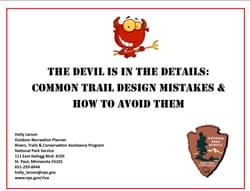




Common Trail Design Mistakes and How to Avoid Them
This presentation discusses how to avoid common trail design mistakes.

Presenter: Holly Larson is an Outdoor Recreation Planner for the National Park Service's Rivers, Trails, and Conservation Assistance Program
Hard surfaced trails look simple on the ground, but are not as easy to design as they seem. Details that can make trails safer, more user-friendly and more accessible often get overlooked. Examples of good and bad design for details such as at-grade crossings, trail surfaces, user-specific trail specifications, bridges, tunnels, trailheads, signage and landscape elements are discussed with photos and drawings from around the U.S.
877 views • posted 02/19/2018